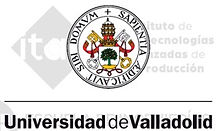
ITAP - Medical Robotics


ROBOTIC DEVICE FOR TERMINAL GRIP (END-EFFECTOR) FOR NEURO-REHABILITATION OF HIGHER MEMBERS, WITH ACTIVE THERAPIES, SELF-ADAPTED TO THE NEEDS OF EACH PATIENT (E2REBOT)
Funding entity: CDTI, cooperative research and development project
Code: IDI-20130740.
Consortium formed by companies: APLIFISA S.L., IDES, IDECAL, Benito Menni Hospital Center and CARTIF Foundation Technology Center.
Duration: 01-April-2013 - - 31-June-2015



The main objective of the project is the creation, development, implantation and clinical tests of a new prototype of intelligent robotic device, with a terminal grip ("end-effector" in Anglo-Saxon terminology), for neuro-rehabilitation of the upper limbs, in patients with Acquired brain damage.
This robot will allow the realization of auto-adapted neuro-rehabilitation therapies "on-line" to the needs of each patient (paradigm "assistance as needed"), through control strategies based on haptic, physiological and visual feedback. This last feedback will be improved and strengthened by consisting of itself in a therapeutic tool for DCA by integrating an adaptation of the GRADIOR system of neuropsychological rehabilitation, allowing the patient not only to develop a significant task of motor neurorehabilitation through virtual scenarios but also, at At the same time, rehabilitation of their cognitive superior functions, damaged by the injury or capable of being trained.
The haptic feedback will be used to control the robotic device, and make it compatible with the patient's interaction. To make the robot compatible with the biomechanics and dynamics of human beings, an admittance control at the Cartesian level will be implemented, through which the robot will be able to generate haptic forces, based on a great variety of virtual objects of a viscoelastic nature. . A trajectory planner will also be developed based on the "minimun jerk" strategy, which provides more "friendly" robot movements during rehabilitation tasks The physiological feedback will be based on the analysis of the signals of the cardiac rhythm and the galvanic skin response of the patient. This will allow the robot to adapt "to the needs of each patient, dynamically regulating the amount of assistance / resistance of each therapy, depending on the values of these patient's physiological signals, which are measured and processed" on-line ", while the patient performs rehabilitation activities assisted by the robot. In this way, the intensity of the therapy is combined with the patient's state of health, being able to detect and correct (varying the intensity of the activity performed), situations of stress and anxiety in the patient, which could compromise the outcome of the program. planned rehabilitation.
Visual feedback is one of the strengths of this project: It consists of highly motivating virtual scenarios that provide a real motivation to the patient in order to achieve greater involvement in the rehabilitation treatment. These scenarios will incorporate elements that will allow the accomplishment of tasks to carry out the rehabilitation therapies of the motor function, with different degrees of difficulty, adapted to the patient's capacities, and initially calibrated according to the range of mobility of said patient.

E2REBOT: Robot developed in the project for neuro-rehabilitation of upper limbs, with active therapies, self-adapted to the needs of each patient.